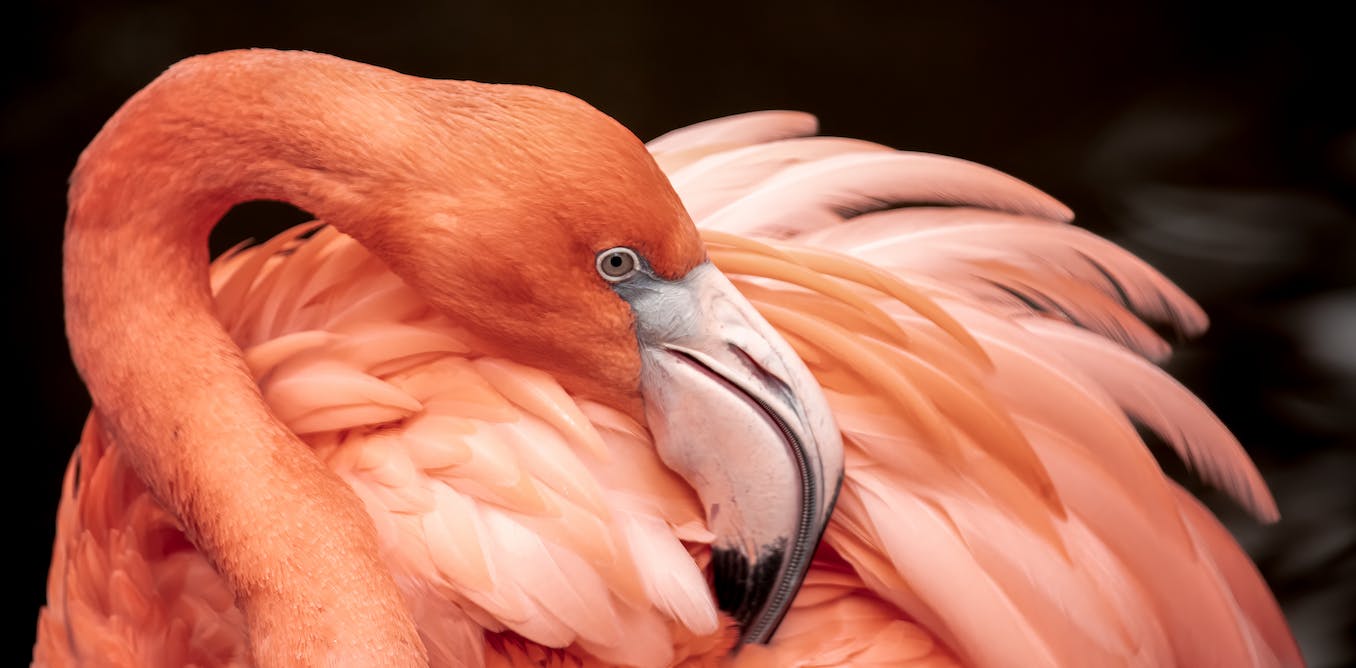As social animals we have an innate understanding of the joy a good friendship can bring. So it’s unsurprising humans delight in seeing such closeness between animals. We can see ourselves reflected in the behaviour of cuddling chimpanzees, but a new wave of research is showing less relatable animals have pals too.
Our team’s new research found that while flamingos appear to live in a very different world to humans, they form cliques much like human ones. Like us, flamingos have a need to be social, are long lived (sometimes into their 80s) and form enduring friendships. Paul Rose’s previous work indicates captive flamingos are as picky about their friends as we are. They spend their time with preferred companions and depend on them for support during squabbles with rivals.
A flamingo’s inner circle can include their breeding partner plus several friends. Flamingos will form both platonic and maybe even sexual bonds with birds of the same sex and can form mixed sexed trios and quartets. These relationships can last for decades.
Wise humans know you can’t be friends with everyone. Paul was keen to learn why the flamingos formed friendships with some birds but not others. Animals choose their companions according to all sort of rules. Some of them do it by body length, for example guppies, others by age, such as in albatrosses. Personality impacts friend choice in many species such as chimpanzees (and, of course, humans).
jdross75/Shutterstock
Throughout his project studying long term flamingo friendships, Paul noticed flamingos living on Wildfowl and Wetlands Trust (WWT) reserves (and indeed those that live in zoos) formed cliques not unlike children in a playground. There were the popular kids, the bullies, the quiet ones in the corner… always the same birds and nearly always together. This provided a perfect opportunity to test if these personality cues might help explain how flamingos find their friendship groups.
Fionnuala McCully was recruited to address this question as part of her masters in animal behaviour. She set about documenting the dramatic lives of the Chilean and Caribbean flamingos housed at WWT Slimbridgein Gloucestershire, south-west England. Each bird carried a leg ring with a unique code, which she used to tell them apart and establish who was spending time with who. Working out these friendship groups took a lot of observation – four months to be exact.
By scrutinising the birds’ behaviour over the days and months, Fionnuala built a personality profile for every flamingo in each flock. Aggressive birds would often be spotted intimidating their flock mates, while submissive birds avoided conflict. Then, we used a technique called social network analysis to investigate the relationships within each flock, and whether personality could explain the friendships.
The answer was yes. The flamingos in both flocks tended to have friends who where similar in personality. In the Caribbean flock, the importance of personality ran deeper. Aggressive, outgoing birds had more friends compared to quieter flockmates. These confident cliques also spent more time in each other’s company than less outgoing groups. Caribbean flamingos were more willing to start fights and enter a fray to defend their friends. In contrast, there was no evidence to suggest outgoing Chilean flamingos had more friends, nor were they more willing to aid their buddies during rows. This shows that what is true for one species may not be true for the others, even when they are closely related. Caribbean and Chilean flamingos, for example, both have the same body structure and foraging behaviour.
Our work demonstrates how flamingos need space and time to choose and maintain their own friendships. When a flock is large enough for all different personality types to be represented, each flamingo has the opportunity to find a social partner of its liking. Keeping flamingos within the same flock across several breeding seasons helps them work out “who is who” and get better at forming compatible relationships once they have worked out the social dimensions of the group. Flamingo breeding is a numbers game – the more birds, the greater the chance of success. So understanding choosy flamingo friendships can help staff take good care of captive flamingos and manage populations.
As behaviour scientists, we are discouraged from comparing animals directly to humans as it can increase the risk of biasing our work with human values. But sometimes we can’t help ourselves. For example, the king and queen of the Caribbean flock were a particularly outgoing mated pair who Fionnuala affectionately nicknamed “the Beckhams”.
More and more studies are revealing the complexity of animals’ social lives, which makes it harder to ignore our reflections in research findings. Using human behaviour as a blueprint might give us valuable clues into what animals need to be happy. This is applied more easily to some species (such as primates) than others. However it is critical that science doesn’t neglect the social needs of animals simply because they are considered less “clever” or “relatable” than other species in the zoo. If humans require friendships to be happy, is it really such a great leap to think that flamingos might need the same?


